The 60-Day Ecommerce Popup Roadmap: From Setup to Revenue Impact

Read summarized version with
What you’ll have in 60 days:
Popup system capturing emails, recovering carts, and promoting sales and offers
4-5 campaigns running, each targeting a different visitor segment
Proven incremental revenue (backed by A/B testing with control groups)
Clear ROI story for your CFO
Documentation of what works (and why)
Email automation welcoming popup subscribers
Framework for testing new visitor engagement ideas
No theory here—only tips based on our experience working with ecommerce stores making between $500k and $5M annually.
If you’d like to actually drive measurable revenue with popups, this guide will help you build a system to make them a real ecommerce growth channel. Even if you haven’t used popups before or find them annoying.
Test your popup strategy risk-free
Get everything you need: pre-built templates, A/B testing with control groups, revenue tracking, and integrations with your stack. Use for free for 14 days.


Month 1: Launch your strategy
Week 1: Install, set up, launch the first campaign(s)
Day 1: Installation (<30 minutes)
If you're on Shopify:
Go to the app store, search for “popups”, choose an app and install.
Popular options:
Wisepops (4.8 Shopify rating, 160+ pre-built popup templates with triggers, 14-day free trial)
Other top-rated options: Best popup apps for Shopify
Look for these features when choosing a popup platform:
Pre-built templates with triggers already configured
Ecommerce features like deep Klaviyo integration
Easy drag-and-drop customization in the editor
Built-in A/B testing with control groups
Revenue and goal tracking
Day 1-2: Set up goal and revenue tracking (30-40 minutes)
Before you launch anything, set up tracking. This is how you prove ROI, so it’s a critical step.
In your popup platform’s settings:
Select your currency for revenue tracking
Set attribution window to 1-3 days
You can do so in literally a few clicks. For example, in Wisepops, you go to Settings > Goals and specify your preferences:
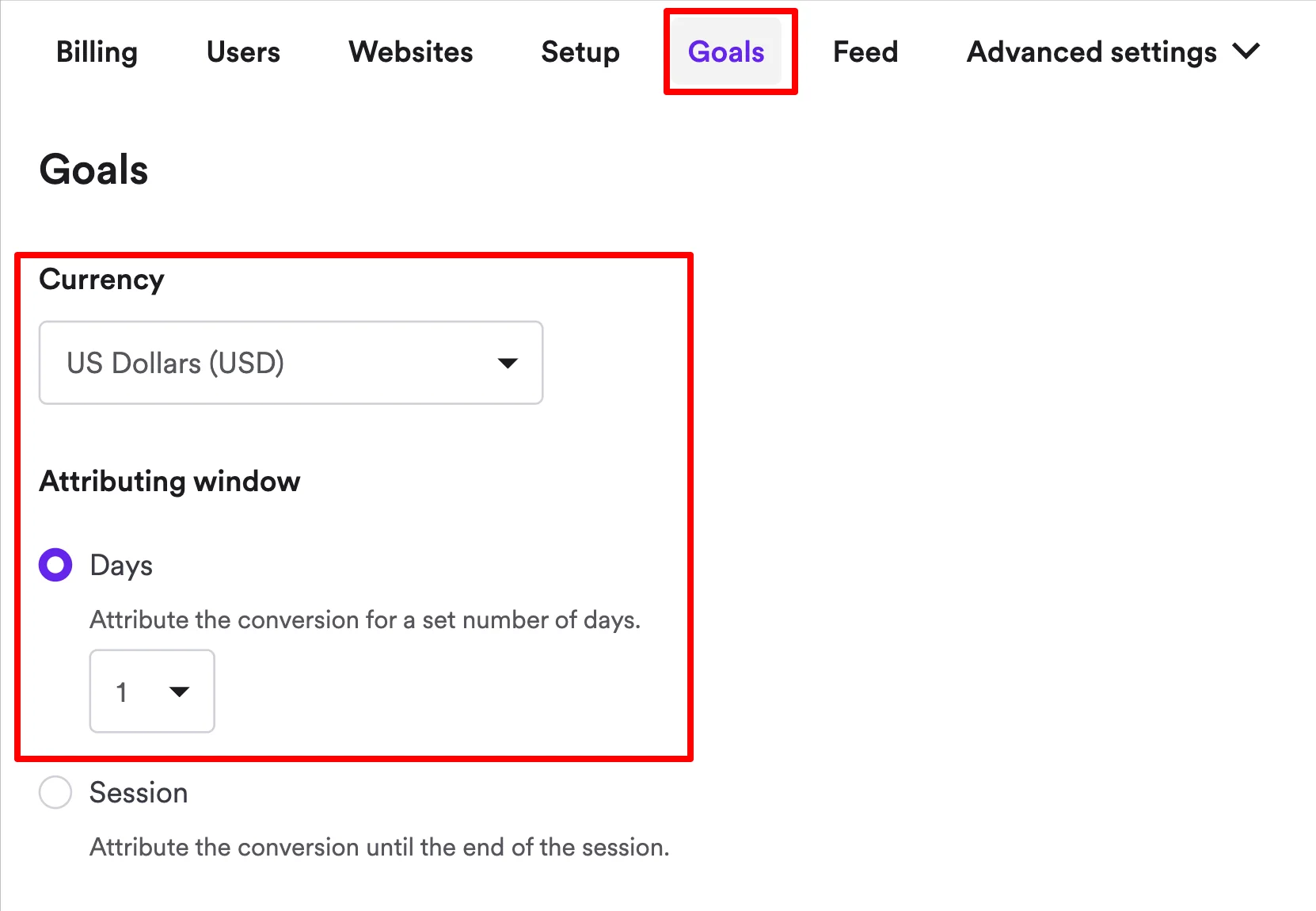

Next:
Set up goal tracking (completed orders, email signups, etc.)
Add the URL that defines an achieved goal (example: a checkout page)
Name the goal and save
See below the goal setup for a completed order—here, visiting the “checkout completed” page is the achieved goal. Also, I’ve added “$30” as the attributed revenue, which is the price for the target item (umbrellas).
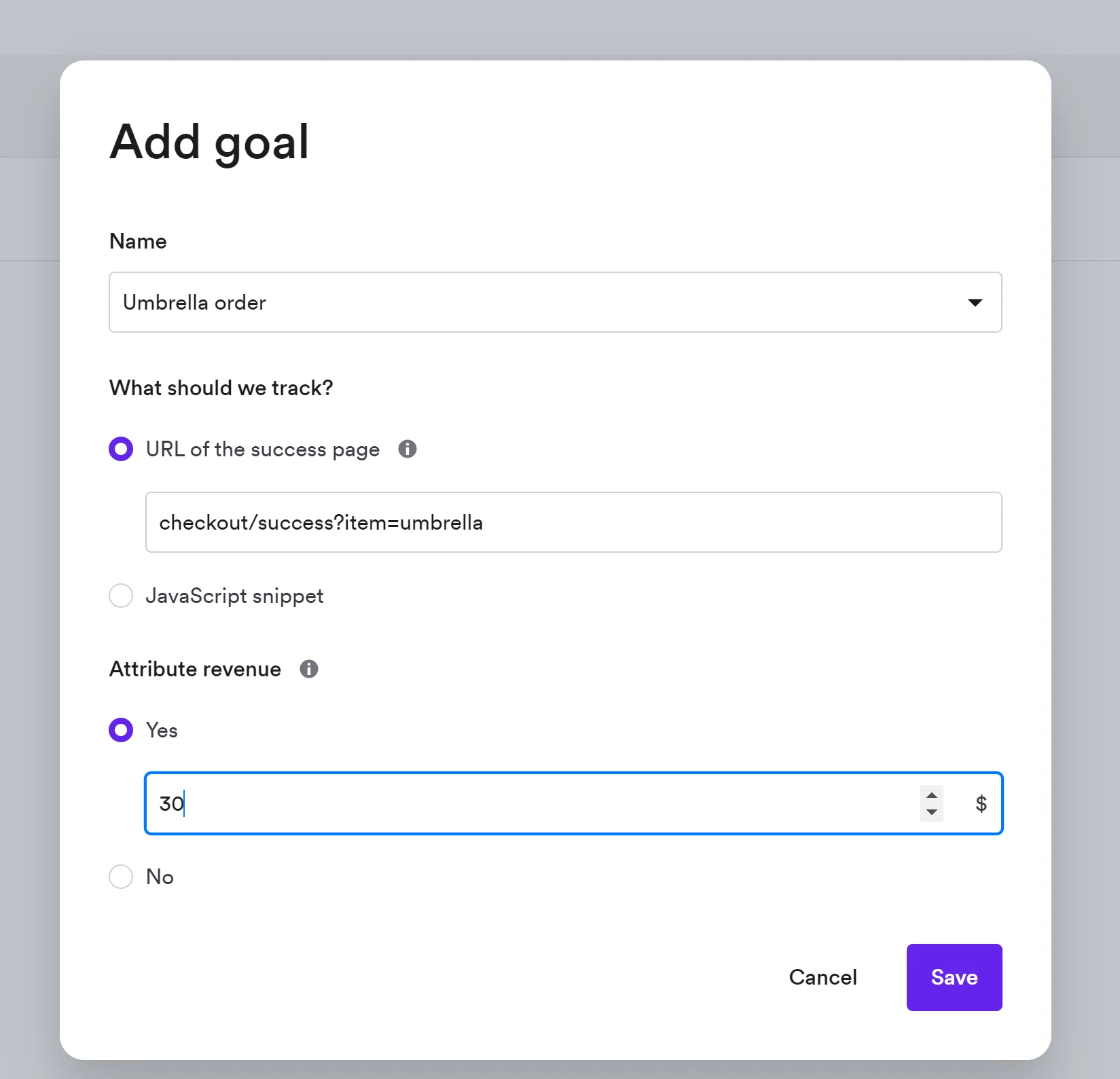

When you’re done setting up goal tracking, you’ll also be able to assign them to individual campaigns just before publishing them.
Day 2-3: Create and publish your first campaign(s) (1 hour)
Let’s make sure that our first campaign has a clear, immediate, and measurable impact on your marketing strategy. Consider these campaign ideas for your first project.
Campaign A: Welcome offer
Campaign B: Cart abandonment popup
Campaign C: AI product recommendations
Best if: You have decent traffic but low email capture rate
Goal: Build an email list
Typical offer: 10% off first purchase, free shipping, or free resource
Trigger: 25-30 seconds after landing on your website
Design: multi-step: email capture + discount reveal & bestseller recommendations
Best if: You have high cart abandonment (80%+)
Goal: Recover abandoned carts
Typical offer: "Here's what you're leaving behind" reminder (sometimes with 5-10% incentive)
Trigger: When customer leaves cart page or site with items in cart
Design: Show products in cart as a reminder. If using a discount, add countdown to create a sense of urgency to complete the order.
Best if: You have low website conversion rate (<2%) but good traffic
Goal: Stop site abandonment and improve product discovery
Typical offer: Free shipping reminder + product recommendations based on browsing history
Trigger: exit intent
Design: Three recommended products picked by AI based on the browsing history of each visitor and sales performance

Welcome Offer
Turn new visitors into subscribers with an instant discount + show social proof

AI-Powered Cart Recovery
Predict cart abandonment before it happens with AI to maximize recovery rates

Shopping Suggestions
Personalized recommendations shown on product pages
Consider these ideas:
> To improve email capture and sales: campaign A (welcome) and campaign C (product recommendations)
> To capture emails and recover carts: campaign A (welcome) and campaign B (cart recovery)
> To improve sales with personalization: campaign C (product recommendations).
When you pick your campaigns, customize their design in your popup editor. Have your designer prepare some nice visuals or use lifestyle images of your products for a great look.
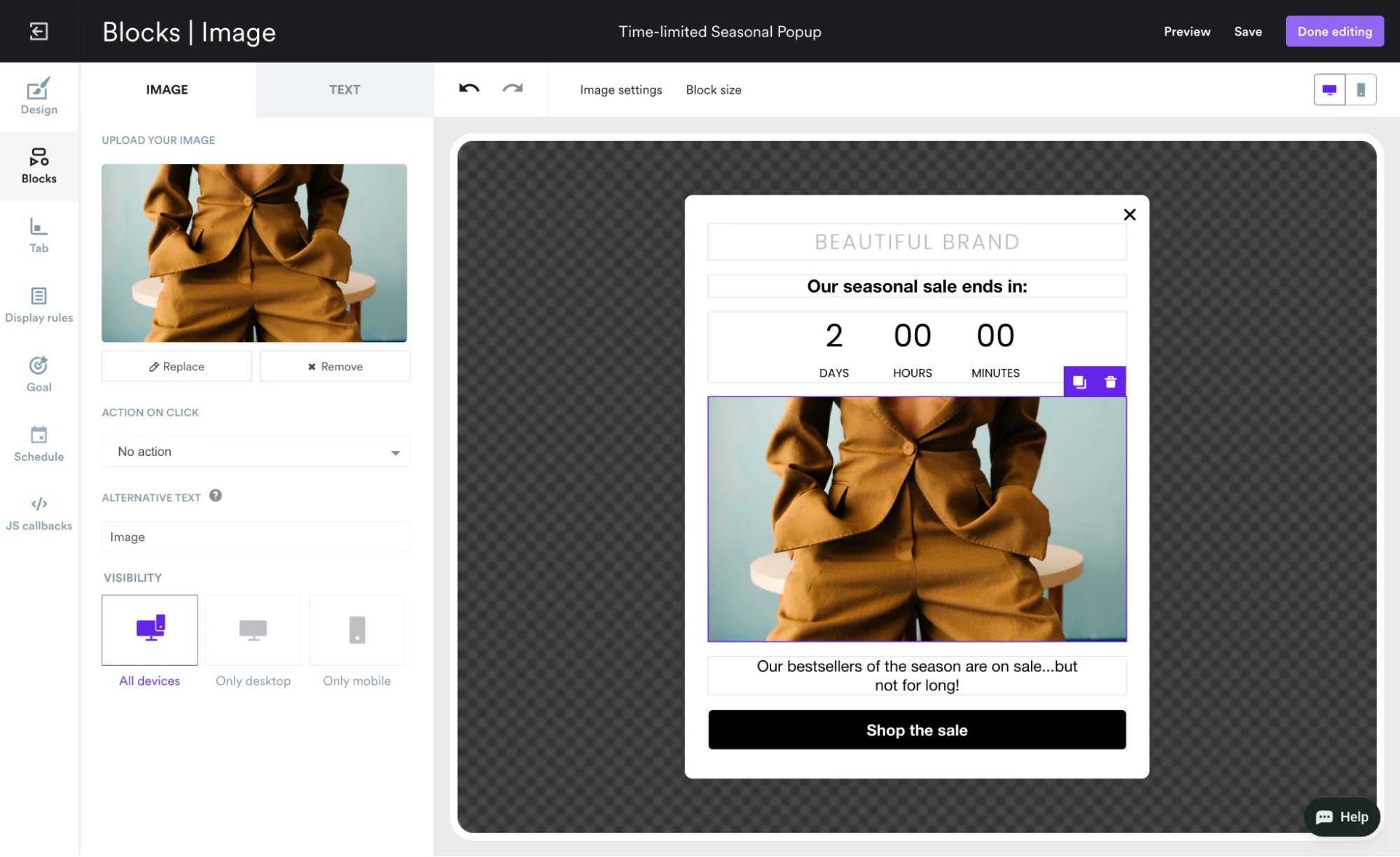

This share may be explained by the fact that some shopping cart addition confirmation widgets and windows may already contain related items (which is another great way to do Shopify upsell).
Still, using popups for upsell on Shopify has many benefits:
they work on autopilot
they provide personalized product recommendations thanks to AI
they are more effective at capturing visitors' attention than other channels
This video will help with popup campaign customization:
Once you’re done with customizing the design—
Go live with the first campaign.
After you published, check:
No errors reported by your popup tool
Popup displaying correctly on desktop and mobile
Performance analytics and revenue tracking show numbers in 24 hours
Day 4: Set up email automations (2-3 hours)
Integrate your popup platform with your ESP (Klaviyo, Mailchimp, ActiveCampaign, etc.) to enable automatic email sending, subscriber tagging, targeting customer segments.
In the campaign editor, choose the email signup field and go to Sync. You’ll see the list of email marketing platforms and other tools instantly:
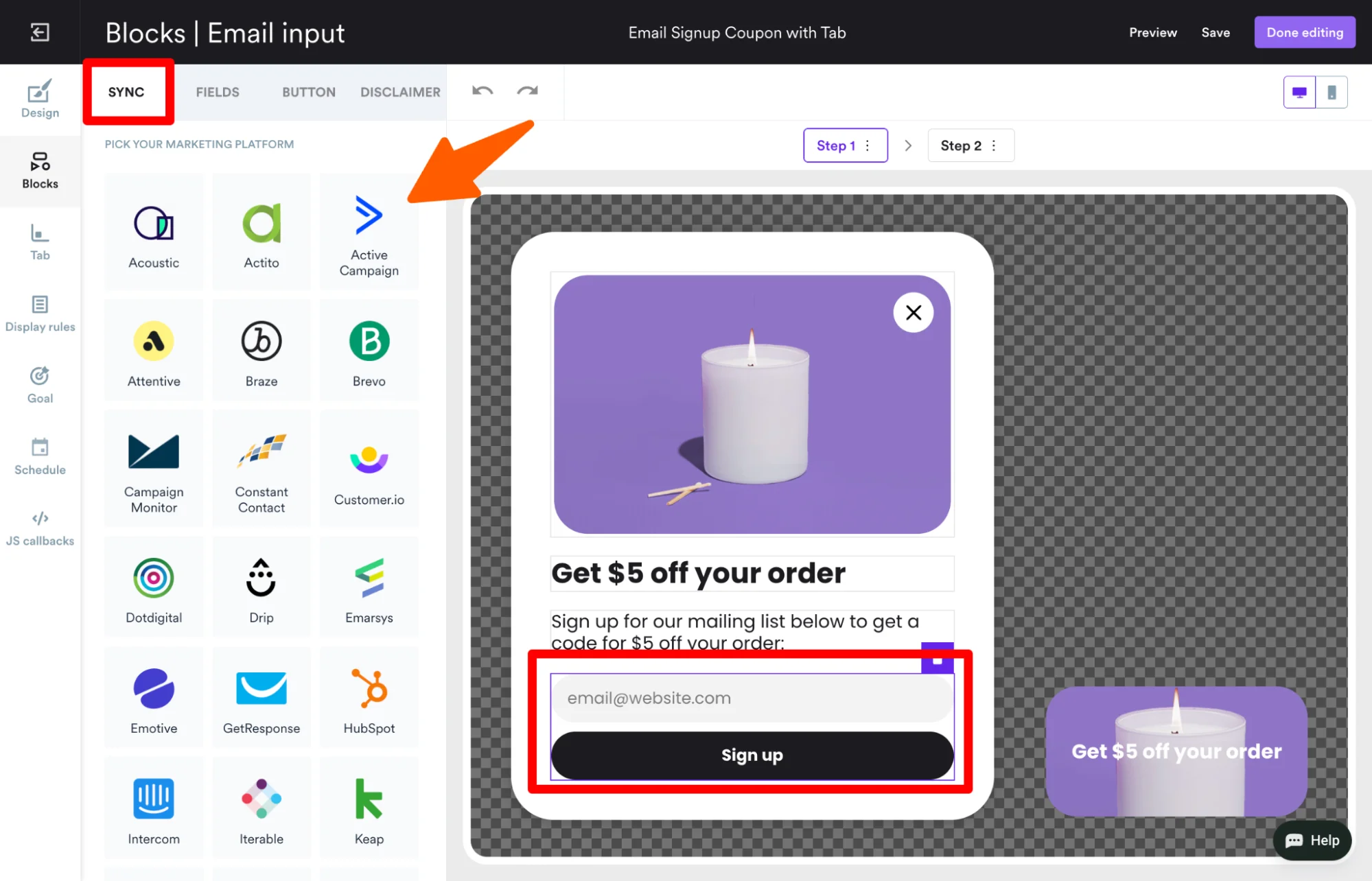


Shopify
Connect your Shopify store to personalize and trigger campaigns based on store and visitor data.

Klaviyo
Target Klaviyo segments with personalized onsite campaigns and sync leads to your Klaviyo lists in real time.

Segment
Connect Segment to send visitor data from Wisepops to your entire marketing stack in real time.
Next, create automated email sequences—they should be pre-built before you publish the popup campaigns on your website.
A welcome email automation
When someone signs up through a popup:
Minute 0: Deliver what you promised (discount code, guide, free shipping)
Day 1: Gentle product introduction (don't hard sell yet)
Day 3: Social proof (reviews, customer stories)
A cart recovery email automation
When someone abandons cart:
1 hour: "Your cart is waiting" (just a reminder, no incentive yet)
24 hours: Address the most common objections based on your customer research
72 hours: Final reminder with small incentive
 Note: tag every popup subscriber with campaign source
Note: tag every popup subscriber with campaign source
Tag popup email #1 differently from popup email #2.
In 60 days, you’ll need to know: "Welcome popup subscribers had 12% conversion. Cart recovery popup subscribers had 6% conversion."
Test your email sequences
Go through your own popup. Did you get the email when it was supposed to arrive? Is it tagged correctly? Does it trigger the right automation?
If yes: You're ready for next steps.
If no: Fix before moving forward.
Best output: Emails flow automatically and subscribers are tagged by source. Automations run without manual work.
Day 4: Set up A/B testing (1-2 hours)
Note: you need around 20,000 visitors per variant for reliable A/B tests. With less traffic, consider using heatmaps, surveys, or visitor recordings instead.
This is your revenue/impact proof mechanism for your CFO.
You have many options to try—for example, you can test a gift with purchase vs 10% discount for first-time customers or a scarcity-based message vs 10% discount for cart recovery.
To set up popup A/B testing:
Choose to A/B test a popup and replicate it. Or, add another one if you’d like to test something entirely different:
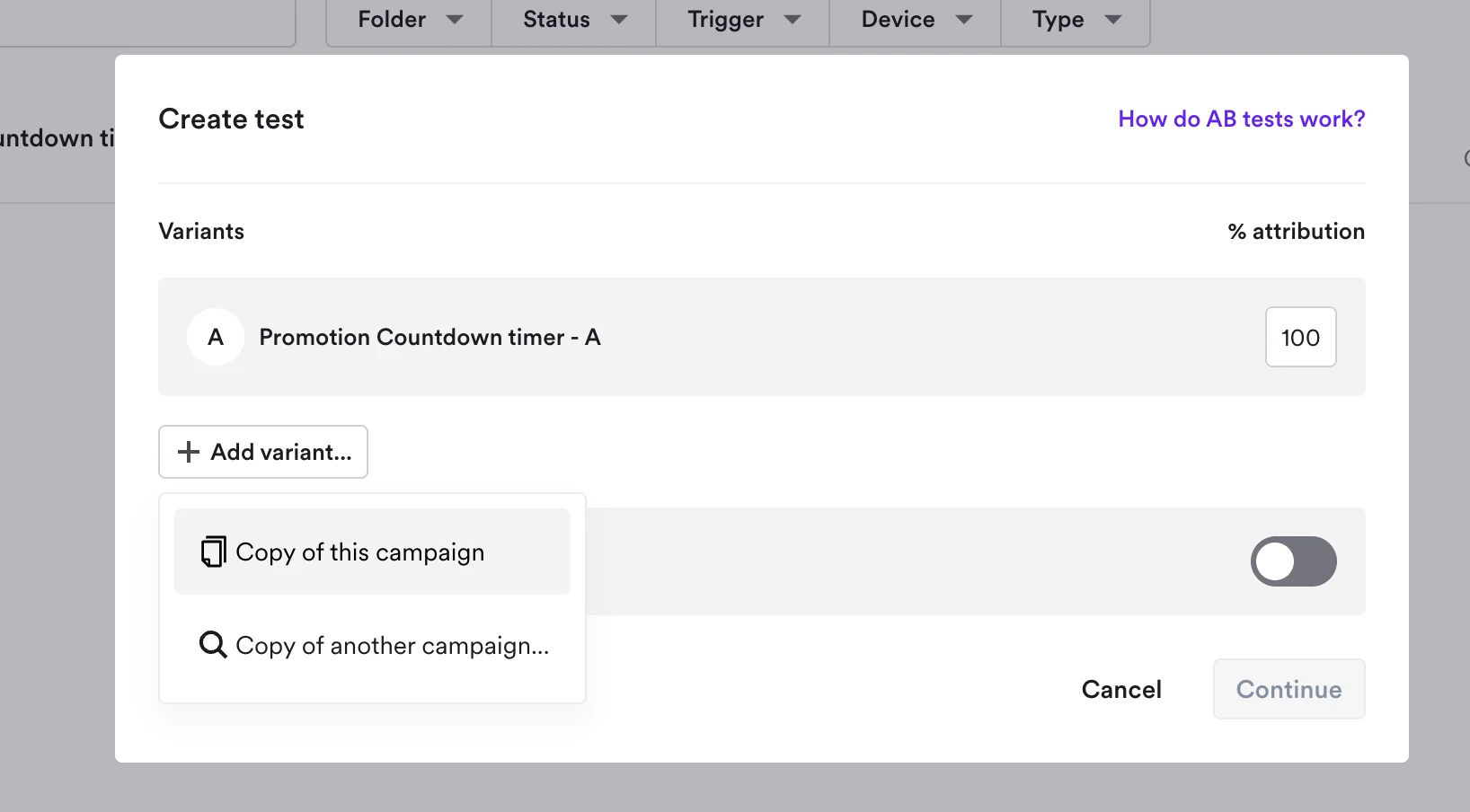

Your popup tool will automatically define how many visitors see each variant: 50%/50%.
If using control groups, it will set 67% for the test groups (34% and 33%) and 33% for control group that will see nothing:
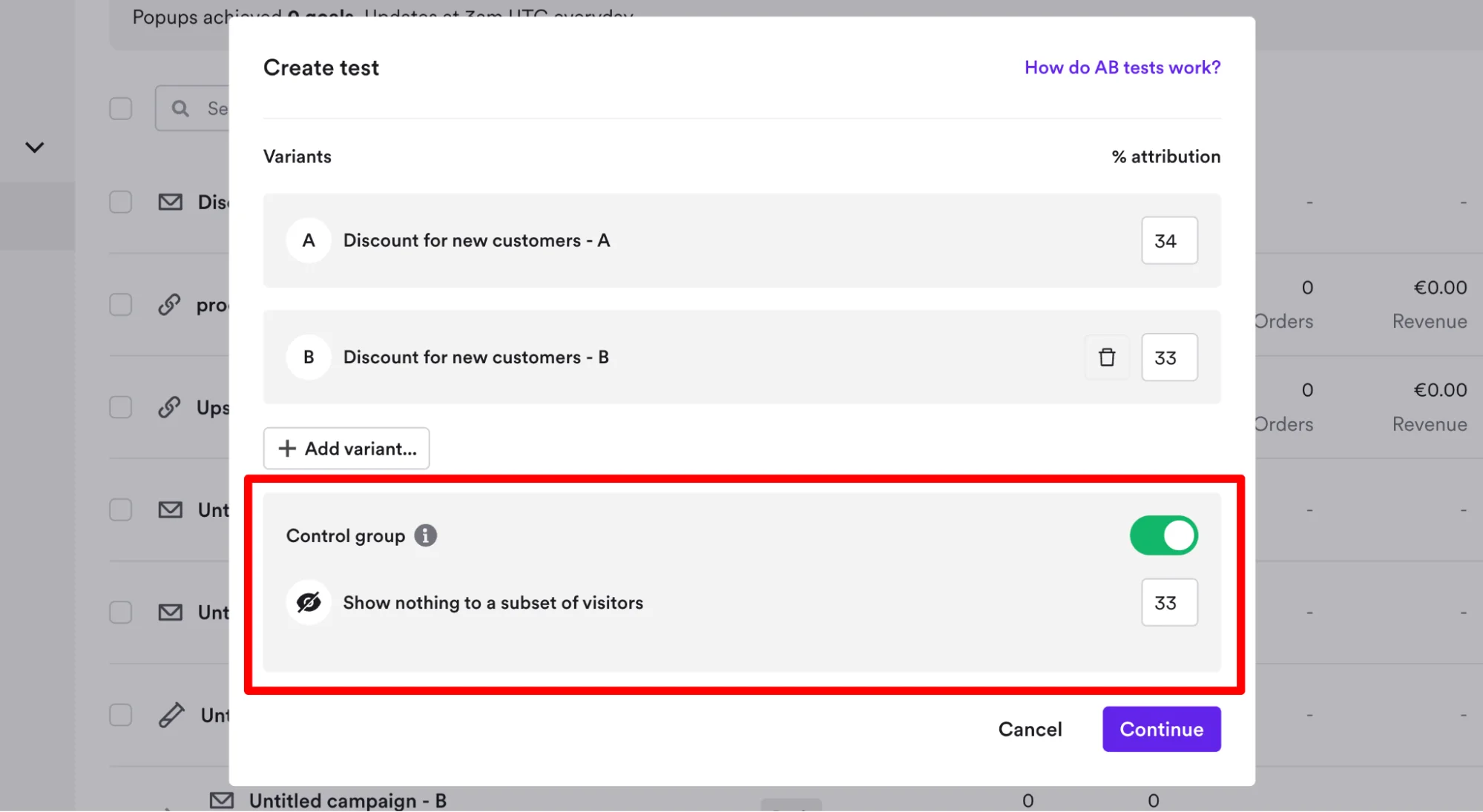

The control group will help you answer this question: "If we didn't have this popup, how many people would have bought/converted anyway?"
That difference is your real improvement.
Example of popup A/B test result with a control group:
Control group: 500 visitors, 12 purchases = 2.4% conversion
Test group: 1,500 visitors, 51 purchases = 3.4% conversion
Your real lift: 1 percentage point
Real incremental revenue: (51 - 45) = 6 additional orders
Ideas for A/B tests in ecommerce
Idea 1: Test the offer
Control: 10% off first purchase
Variation: Free order above a certain order value
Idea 2: Test the timing
Control: 30 seconds after landing
Variation: Exit-intent
Idea 3: Test the copy
Control: Benefit-focused ("Get insider tips and 10% off")
Variation: Urgency-focused ("Limited time: 10% off today only")


Day 5-7: Monitor
You have 2-3 live campaigns with measurement infrastructure in place. You’re tracking results in your analytics dashboard.
By the way, many marketing teams take up to a few weeks to reach this point, so you're way ahead of them!
Week 2-3: Add segment-specific campaigns
Do you and your team have specific marketing goals and ideas for popups you’d like to test?
Personalized offers for loyal customers, improving awareness of time-limited offers, learning more about customers with quick surveys, that sort of thing.
Here are a few worth considering:
Special offer for returning visitors
Browse abandonment campaign
Customer survey on exit
Birthday data collection campaign
Advent calendar
Loyalty program promotion
Campaign idea 1: Special offer for returning visitors
When: 30-40 seconds after landing
Offer: Give a personalized discount for orders above $X
Segmentation: Returning visitors only (exclude new visitors)
Where: product category and individual product pages
Examples:
A discount code for returning visitors viewing a product category page (that suggests a real interest in buying):


A variation of this campaign is a best seller promotion.
Instead of the discount, you showcase the most popular product from the category a visitor is viewing:


Campaign idea 2: Browse abandonment
Who: Visitors viewing products but leaving without action
When: Exit-intent (when they're about to leave the site)
Message: show personalized product recommendations based on browsing history
Segmentation: First-time visitors only (returning visitors already know your offer)


Campaign idea 3: Customer survey on exit
Who: Visitors viewing 3+ pages but leaving without action
When: Exit-intent (when they're about to leave the site)
Content: first window with a button to the survey; second window with an embedded survey containing a few multiple-choice questions
Segmentation: All visitors, once in a week or two
Example:
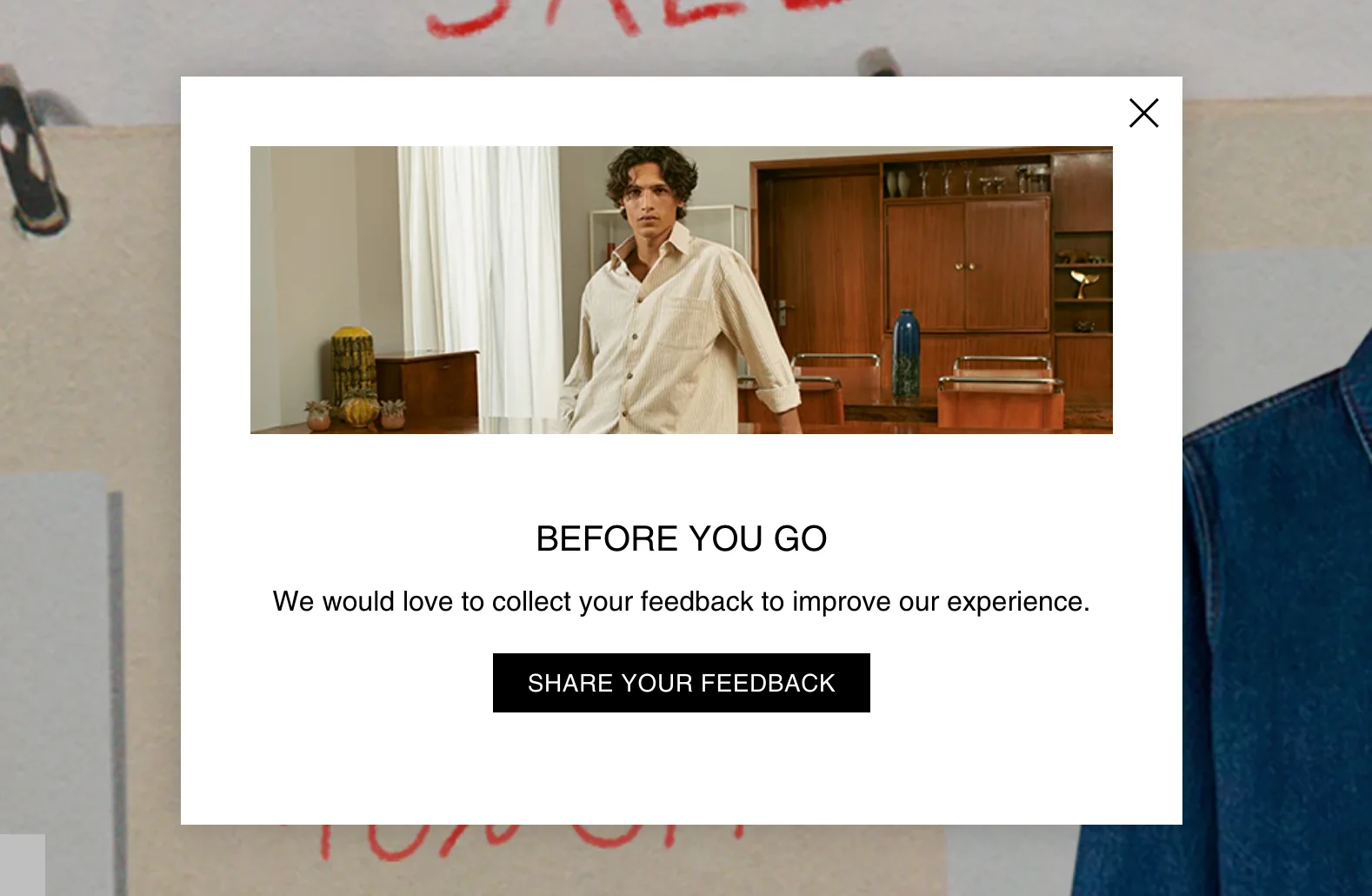

Campaign idea 4: Birthday data collection campaign
Who: Registered visitors who haven’t added their birthdays in their profile
When: 30-40 seconds after landing, after one pageview
Design: a lightbox, corneredContent: a signup field including birthday date
Example from Nkuku:
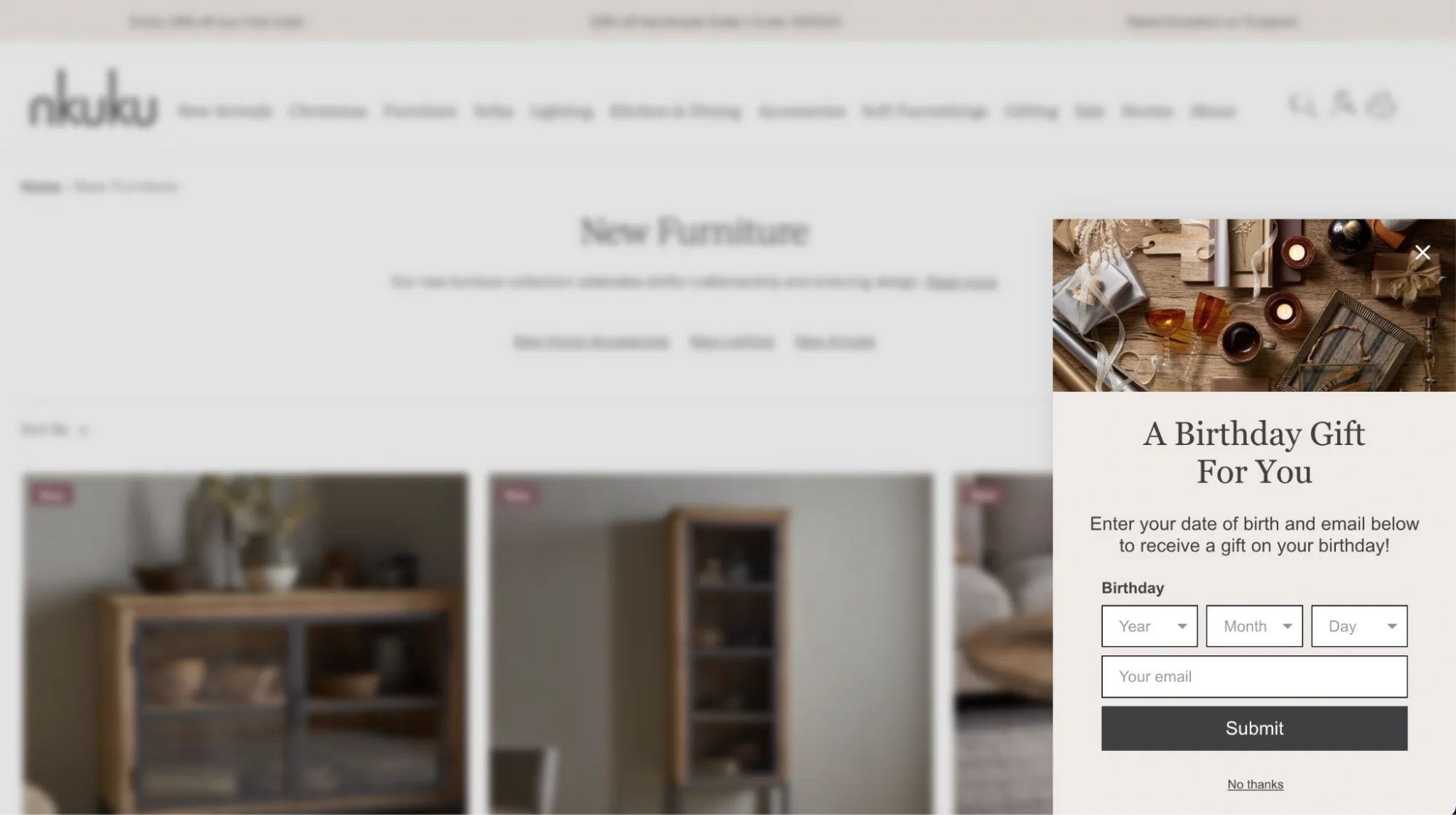

Campaign idea 5: Advent calendar
When: 10-15 seconds after landing, first page
Content: advent calendar with a unique gift for every day
Design: centered or slide-in
Segmentation: All visitors
Example from Aime:


Another example from CODAGE Paris:


Convert more visitors during holidays
See how to create an advent calendar in minutes thanks to a pre-made template:
Campaign idea 6: Loyalty program promotion
Who: Visitors viewing 2+pages
When: 30-40 seconds after landing
Content: a list of benefits of subscribing and a link to the signup page
Segmentation: All visitors
Example from Nutrimusle:
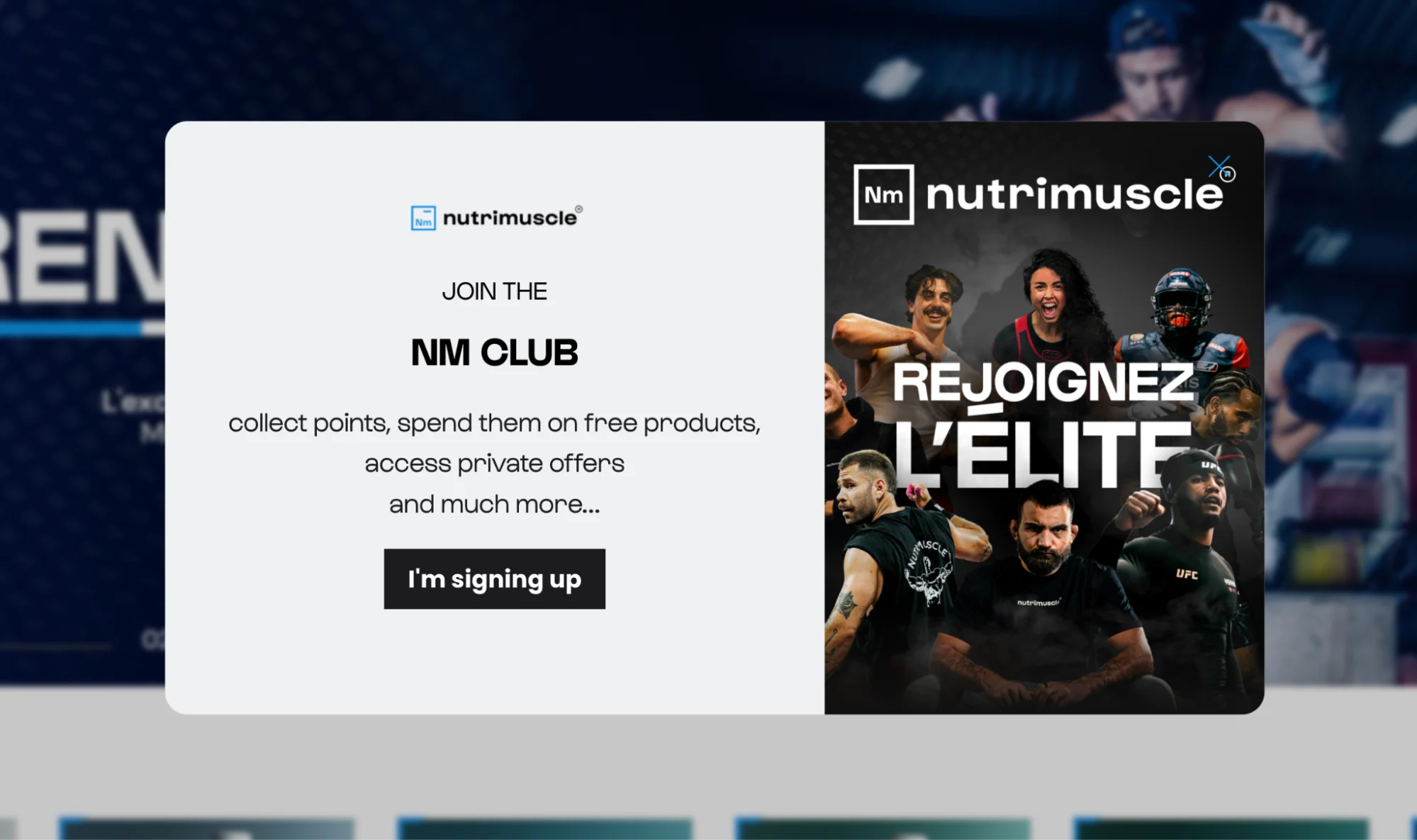

End of week 3 output:
You have 3-4 campaigns running, each targeting a different segment and solving a different problem. Your popup strategy is taking off.
Key metrics to track during month 1
Metric
Target
Why It Matters
Email capture rate
2-15%
Shows if your offer is compelling
Revenue tracking accuracy
100%
Without this, you have no proof of effectiveness
Visitor reach
20-50% of traffic
Shows reach without overwhelming
A/B test results
Statistically significant by week 5-6
Proves real impact vs. noise
Month 2: Strategy optimization
Week 1-2: Analyze 1st month data and adjust
Check the performance data from your A/B test to prove ROI.
Calculate incremental revenue
From your A/B test (control vs. test group):
Incremental monthly revenue = (Test conversion % - Control conversion %) × Monthly visitors × Average order value
Example calculation:
Control conversion: 2.8%
Test conversion: 3.4%
Lift: 0.6 percentage points
Monthly visitors: 50,000
AOV: $75
Incremental revenue: 0.006 × 50,000 × $75 = $22,500/month
Year 1 ROI: ($22,500 × 12) / $6,000 popup cost = 45x ROI
This is the number you show your CFO. If it's positive, then your strategy is justified.
If your final number is negative, compare:
Subscribers from Welcome campaign: What % converted to purchase? What was AOV?
Subscribers from Cart Recovery: What % converted to purchase? What was AOV?
Organic email subscribers (no popup): What % converted to purchase? What was AOV?
The best popup isn't the one that captures the most emails but the one that captures emails with the highest customer lifetime value.
Document the tactics that are working
By this point, you should have:
Clear incremental revenue number
Email capture rate by campaign
Average conversion rate by segment
Email engagement metrics (open rate, click rate by campaign)
Report with revenue impact for your CFO
End of week 1-2 of month 2: You can justify your popup investment to finance now. You know which campaigns work. You have data for good CRO decisions.
Week 3-4: Optimize and document your results
Double down on the best campaigns
By now, you know:
Which campaigns drive the most incremental revenue
Which segments respond best to your popups
Which offers and incentives convert best
Document your CRO strategy
Create a one-page playbook:
IF “visitor type” → THEN SHOW “campaign X”
Example:
Campaign
IF (segment + behavior)
THEN (trigger + message)
Goal
1. Multi-step welcome flow
New visitor + 10 sec on page OR 2 page views
SHOW multi-step popup (email → phone + segmentation → discount + bestsellers)
Email + phone capture + guided discovery
2. Exit-intent cart recovery
New/returning visitor + items in cart + exit signal
SHOW live cart contents + discount incentive + countdown timer + copyable code
Recover abandoned carts
3. AI product recommendations
New visitor + 5+ page views + exit signal
SHOW 3 personalized products based on browsing (no discount required)
Convert on relevance, reduce drop-off
4. Free shipping promo
Visitor with $0-50 in cart
SHOW the free shipping threshold nudge when an item added to cart
Improve average order value
5. Increase customer lifetime value
Visitor + 3 §page views + orders_count ≥ 3, logged in
SHOW Value-add alternative (free expedited shipping, double loyalty points) to loyal customers
Protect margin on high-value orders
Prepare for next month
Identify what you'll test next:
New campaign types (cart content-based, offers for paid traffic, spin-to-win wheels)
New segments to target (paid visitors, high-cart-value visitors, etc.)
New offer types (tiered discounts, bundles, exclusive access)
End of week 3-4 of month 2 output: You have a proven system and you know what works. You're ready to scale!
Month 2 (Performance metrics to track)
Metric
Target
Why it matters
Incremental revenue
Positive
Proves ROI
Conversion rate by campaign
Over 10% on average
Shows what's working
Cart recovery rate
5-10% of abandoned carts (popups + email)
Shows impact on bottom line
Common popup strategy mistakes in ecommerce
Quite often, I’ve seen popup strategies fail because they were treated almost like set-it-and-forget-it tools. The problems with this approach are a lack of proper goal and revenue reporting, poor personalization, and no A/B testing, to name a few.
Mistake 1: Not setting up goal and revenue tracking before launch
Result: It’s almost impossible to prove ROI.
Fix: Do this on Day 1.
Helpful: how to set up goal and revenue tracking
Mistake 2: Using discount popups for everything
Result: Customers trained to wait for deals, margins erode.
Fix: Test free shipping, content offers, product recommendations.
Helpful: 30+ types of popup campaigns
Mistake 3: Launching one campaign and forgetting it
Result: Results plateau after 2-3 weeks.
Fix: Add campaigns every 2-3 weeks, test continuously.
Helpful: 20 ideas to use popups
Mistake 4: Showing the same popup to everyone
Result: Conversion rates drop to 1-2% over time (people see the same offer repeatedly).
Fix: Segment by behavior, visitor segment, and limit displays per session.
Helpful: Popup campaign frequency settings
Mistake 5: Analyzing results after 2 days
Result: Campaigns are shut down before they can even start working.
Fix: Let campaigns run minimum 2 weeks, 100+ conversions before deciding.
Mistake 6: Poor or non-branded design
Result: Low conversion rates and damaged brand perception
Fix: Invest in design that matches your brand because poor design communicates low quality to visitors and trains them to ignore your popups. High-performing popups look intentional and on-brand, not like they came from a generic template.
Helpful: Examples of beautiful popup designs
60-Day Implementation Checklist
Use this checklist to track your progress through the 60-day roadmap. Check off each item as you complete it.
Phase 1: Setup (Days 1-7)
Day 1: Installation & Tracking
Install popup platform (Shopify app or equivalent)
Create account and complete initial setup
Access popup dashboard and editor
Set currency for revenue tracking
Set attribution window to 1-3 days
Day 1-2: Goal & Revenue Tracking
Create goal for completed orders
Add "checkout completed" page URL to goal
Assign revenue value to order goal ($X)
Test goal tracking configuration
Day 2-3: First Campaign Creation
Decide which campaign to launch first (A, B, or C, or combination)
Choose popup template(s)
Customize template design
Write copy and headlines
Add offer/incentive details
Configure trigger (timing or event-based) if needed
Set target audience and other targeting
Preview on desktop
Preview on mobile
Publish campaign(s)
Day 3-4: Email Integration & Automation
Integrate popup platform with ESP (Klaviyo, Mailchimp, etc.)
Test integration with test email
Create welcome email automation
Create cart recovery automation
Set up tagging system for campaign source
Tag welcome campaign subscribers
Tag cart recovery campaign subscribers (if applicable)
Day 4: A/B Testing Setup
Assess traffic volume (do you have 20k+ visitors monthly?)
Decide what to A/B test first (offer, timing, or design)
Duplicate first campaign to create variant B
Edit variant B with test change
Enable control group (if traffic sufficient)
Set control group to 33% (test groups at 34%/33%)
Launch popup A/B test
Day 5-7: Monitoring
Confirm revenue tracking is recording data
Check email signup data is flowing to ESP
Monitor analytics dashboard for data
Document any issues for troubleshooting
Phase 2: Expansion & Optimization (Days 8-30)
Week 2-3: Segment-Specific Campaigns
Analyze performance of first campaign
Decide which campaign to launch next
Create and customize second campaign
Set up segmentation rules (returning visitors, exit-intent, etc.)
Publish second campaign
Create third campaign following same process
Set up automations for each new campaign if needed
Tag subscribers by new campaign source
By Day 30
Have 3-4 campaigns running (A, B, C + one segment-specific)
All campaigns properly tagged in email system
Revenue tracking live for all campaigns
A/B tests running with sufficient data collection (minimum 2 weeks)
Email automations flowing automatically
Analytics dashboard showing performance metrics
No technical issues or errors
Phase 3: Analysis & Documentation (Days 31-45)
Week 4-5: Data Analysis
Collect A/B test results from each campaign
Calculate test and control group conversion rates
Calculate incremental lift (Test % - Control %)
Determine average order value
Calculate incremental monthly revenue
Calculate Year 1 ROI
Compare performance by campaign type
Compare performance by customer segment
Documentation
Create CFO-ready ROI report
Document email capture rate by campaign
Document conversion rate by campaign
Document email engagement metrics (open rate, click rate)
List which campaigns are top performers
Note which segments respond best
Record which offers/incentives work best
Compile list of what's working (and what isn't)
Phase 4: Scaling & System Building (Days 46-60)
Week 6-7: Optimization & Documentation
Review top-performing campaigns
Identify underperforming campaigns
Consider shutting down or pausing low performers
Plan how to expand traffic to top performers
Create one-page CRO playbook (IF this THEN show that)
Test new campaign ideas identified in month 2 planning
Create or update testing roadmap for Q2
Set up biweekly or monthly reporting meeting
Week 8: Final setup for month 3
Identify 3-5 tests to run in Month 3
Document testing hypothesis for each
Identify new segments to target
Plan new campaign types to test
Set performance targets for Q2
Allocate Q2 budget and resources
Schedule team training on popup system (if needed)
Create monitoring dashboard for ongoing tracking
Set up alerts for performance drops
Document technical setup for future reference
Get started
in minutes
Start converting more visitors today.
Get started in minutes and see results right after.



